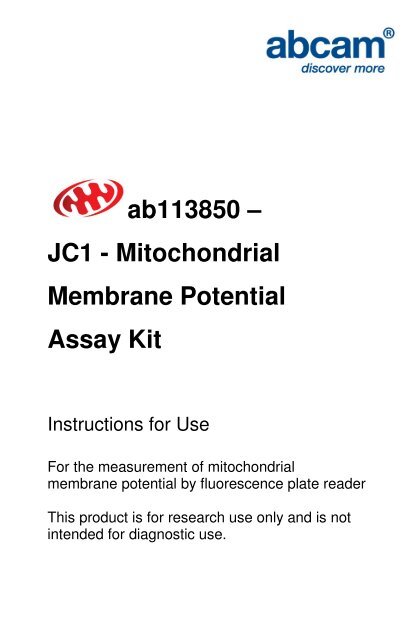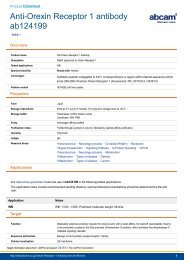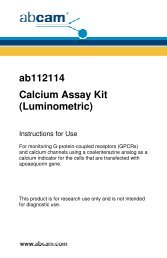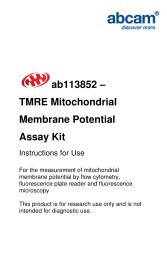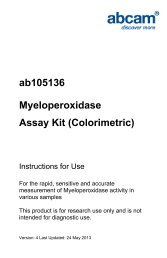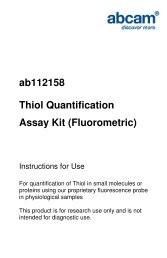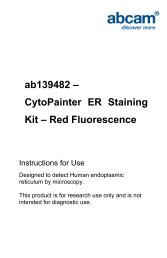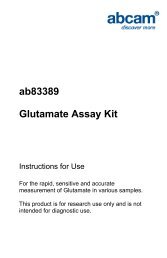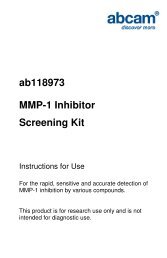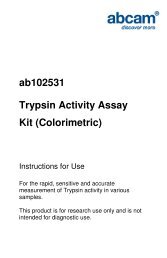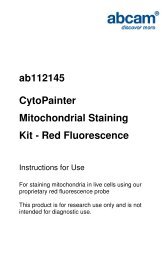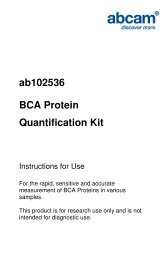ab113850 â JC1 - Mitochondrial Membrane Potential ... - Abcam
ab113850 â JC1 - Mitochondrial Membrane Potential ... - Abcam
ab113850 â JC1 - Mitochondrial Membrane Potential ... - Abcam
- No tags were found...
You also want an ePaper? Increase the reach of your titles
YUMPU automatically turns print PDFs into web optimized ePapers that Google loves.
<strong>ab113850</strong> –<strong>JC1</strong> - <strong>Mitochondrial</strong><strong>Membrane</strong> <strong>Potential</strong>Assay KitInstructions for UseFor the measurement of mitochondrialmembrane potential by fluorescence plate readerThis product is for research use only and is notintended for diagnostic use.
Table of Contents1. Introduction 32. Assay Summary 53. Kit Contents 64. Storage and Handling 65. Additional Materials Required 76. Assay Procedure 87. Data Analysis and Sample Data 132
1. IntroductionThis mitochondrial membrane potential (∆ψm) kit <strong>ab113850</strong> usestetraethylbenzimidazolylcarbocyanine iodide (JC-1), a cationic dyethat accumulates in energized mitochondria. At low concentrations(due to low ∆ψm) JC-1 is predominantly a monomer that yieldsgreen fluorescence with emission of 530±15nm. At highconcentrations (due to high ∆ψm) the dye aggregates yielding a redto orange colored emission (590±17.5nm). Therefore a decrease inthe aggregate fluorescent count is indicative of depolarizationwhereas an increase is indicative of hyperpolarization. Theaccompanying FCCP (carbonyl cyanide 4-(trifluoromethoxy)phenylhydrazone) is an ionophore uncoupler of oxidative phosphorylation.Treating cells with FCCP eliminates mitochondrialmembrane potential and <strong>JC1</strong> staining. <strong>JC1</strong> is suitable for thelabeling of mitochondria in live cells and is not compatible withfixation.<strong>Membrane</strong> potential (∆ψm) is highly interlinked to manymitochondrial processes. The ∆ψm controls ATP synthesis,generation of ROS, mitochondrial calcium sequestration, import ofproteins into the mitochondrion and mitochondrial membranedynamics. Conversely, ∆ψm is controlled by ATP utilization,mitochondrial proton conductance, respiratory chain capacity andmitochondrial calcium. Hence pharmacological changes in ∆ψm can3
e associated with a multitude of other mitochondrial pathologicalparameters which may require further independent evaluation.Depolarization can be found in the presence of ionophores that couldinduce nonselective cation channels or become selective mobileionic carriers. Protonophores such as FCCP and CCCP inducereversal of the ATPase, as a compensatory mechanism that tries tomaintain ∆ψm, which will deplete ATP even in the presence of anormal glycolytic pathway. Hyperpolarization could be found in thepresence of ATPase inhibition, inadequate supply of ADP, increasedsupply of NADH, apoptosis due to oxidative stress and potentiallyproton slippage due to cytochrome c oxidase dephosphorylation. Ineither scenario, OXPHOS uncoupling ensues.Limitations:• FOR RESEARCH USE ONLY. NOT FOR DIAGNOSTICPROCEDURES.• Use this kit before expiration date.• Do not mix or substitute reagents from other lots or sources.• Any variation in operator, pipetting technique, washingtechnique, incubation time or temperature, and kit age cancause variation in binding.4
2. Assay Summary5
3. Kit Contents• <strong>JC1</strong>: 0.5 mg• 10X dilution buffer (sterile): 10 mL• DMSO (cell culture tested): 1 mL• 50 mM FCCP (Carbonyl cyanide 4-(trifluoromethoxy)phenylhydrazone): 0.01 mL4. Storage and HandlingStore all kit components at -20°C in the dark. Lyophilized JC-1 isstable for 12 - 18 months if stored in the dark at -20°C. Once JC-1 isreconstituted in DMSO, aliquot and store at -20°C.6
6. Assay ProcedureThe protocol below is a guideline for measurement ofmembrane potential with two specific cell lines. Use of differentcell lines will require optimization of protocol, in particular theJC-1 concentration and the cell seeding per well.A. Suspension cell culture and treatment (example humanHL60 cells)1. Grow HL60 cells in glucose based media so thatapproximately 2.5x10 7 cells are available on the day of theexperiment per plate2. Make a 1X buffer solution as follows: 90mL of steriledeionized water + 10mL of 10Xbuffer.3. Make a 1X supplemented buffer solution as follows: 18mLof 1X buffer solution + 2mL of FBS.4. If performing toxicity assays, dilute compounds of interest in1X supplemented buffer to 2X of final desired concentrationfor the experiment. A 96-well deep well microplate may beuse in this step. Compounds may also be diluted in completemedia with 10% FBS without phenol red. Include positive(100μM FCCP) and negative controls (vehicle of choice).8
5. Allow JC-1 and DMSO to warm to room temperature.Reconstitute JC-1 in DMSO to generate a 1mM solution (mw652).6. Prepare JC-1 mix as follows: 10mL of 1X buffer solution +10μL of 1mM JC-1 (final concentration 1μM).7. Centrifuge the JC-1 mix at 13,000g for 3 minutes tosediment non-soluble particles.8. Collect cells and wash by centrifugation once in PBS.9. Resuspend cells in 10mL of JC-1 mix and incubate at 37°Cfor 30 minutes in the dark.10. Wash cells by centrifugation with 10mL of 1X buffer solutiononce11. Resuspend 2x10 7 cells in 5mL of 1X supplemented buffer.12. Seed a 96-well dark plate as follows: 200,000 stainedcells/50μL/well. Include blank wells (with non-stained cells).13. If performing toxicity assays, add to each well 50μL ofpreviously diluted 2X compounds and treat for desiredperiod of time9
B. Adherent cell culture and treatment (example human HepG2cells)1. Grow HepG2 cells in standard media so that 3x10 6 to 4x10 6cells are obtained the day before the experiment.2. Harvest cells the day before the experiment and seed a dark96-well microplate with 15,000 cells per well. Allowed toattach overnight.3. On the day of the experiment, make a 1X buffer solution asfollows: 90mL of sterile deionized water + 10mL of 10Xbuffer.4. On the day of the experiment, make a 1X supplementedbuffer solution as follows: 18mL of 1X buffer solution + 2mLof FBS.5. Allow JC-1 and DMSO to warm to room temperature.Reconstitute JC-1 in DMSO to generate a 1mM solution (mw652).6. On the day of the experiment, prepare JC-1 mix as follows:10mL of 1X buffer solution + 200μL of 1mM JC-1 (finalconcentration 20μM). Centrifuge the JC-1 mix at 13,000g for3 minutes to sediment non-soluble particles.10
7. If performing toxicity assays, dilute compounds of interest tothe final desired concentration in 1X supplemented buffersolution. A 96-well deep well microplate may be use in thisstep. Compounds may also be diluted in complete mediawith 10% FBS without phenol red. Include positive (100μMFCCP) and negative controls (vehicle of choice)8. Wash the HepG2 cells seeded on the 96-well plate with100µL/well of PBS once.9. Add 100μL/well of JC-1 mix and incubate for 10 minutes at37°C in the dark. Include blank wells (with non-stained cells).10. Wash the plate twice with 1X buffer solution.11. If performing cytotoxicity assays, add compounds of interestand treat for desired period of time.11
C. Fluorescence Reading1. Set the fluorescent plate reader to perform an endpoint read.2. Set excitation wavelength at 535 ± 17.5nm (aggregateexcitation only) or at 475 ± 20nm (for simultaneousaggregate and monomer excitation)3. Set emission wavelength at 590 ± 17.5nm (aggregateemission only). If reading of the monomer species is alsodesired, set a second emission reading at 530 ± 15nm.4. FCCP 100μM treatment for 4 hours should decrease the JC-1 aggregate signal to at least 25 – 30% from control levels.12
7. Data Analysis and Sample DataSubtract background (A590 of non-stained cells) from test signal andexpress as percentage from control. Data obtained with the JC-1assay gives a relative measure of mitochondrial membrane potentialas a percentage of control and cannot be used for absolutemeasurements of membrane potential in millivolts. Decrease in JC-1signal may indicate either mitochondrial depolarization or cell deathand must be interpreted in parallel with a cytotoxicity assay (such asthe ATP detection kit MS957). The data in Figure 1 below shows theuncoupling effect of FCCP acute treatment on HL60 cells asmeasured with the JC-1 stain and read on a fluorescent plate reader.15,000Fluorescence Counts[A590]10,0005,0000100µm FCCPVehicle control13
Figure 1. <strong>Mitochondrial</strong> membrane potential assay result. LabeledHL60 cells were seeded at 2x10 5 cells per well in glucose based completemedia and treated for 4 hours with 100µM FCCP and vehicle control(DMSO). Cells were then transferred to a microplate and read on aspectrophotometer. Mean and standard deviation is plotted for 3 replciatesfrom each condition.This assay may be used for screening pharmacologicaldepolarization of mitochondria in any cell line. Depending on themicroplate template (see Fig. 2) either 3 or 4 compounds may betested in triplicate dose response per plate.14
A.TreatmentsComponentAComponentBComponentCComponentDABCDEFGH1 2 3 4 5 6 7 8 9 10 11 1215
B.TreatmentsComponentAComponentBComponentCABCDEFGH1 2 3 4 5 6 7 8 9 10 1112Figure 2. Suggested assay templates. Two assay examples are shownabove. The example on the top (A) allows for screening of four compoundsin dose response. Row A contains the diluent control to determine maximalsignal in the absence of compound. Row H contains non stained cells todetermine background fluorescence. The example (B) only allows forscreening of three compounds in dose response with perimeter wells as thebackground fluorescence and column 2 as the diluent titration control.Column 1, column 12, row A and row H contain non-stained cells.16
UK, EU and ROWEmail: technical@abcam.comTel: +44 (0)1223 696000www.abcam.comUS, Canada and Latin AmericaEmail: us.technical@abcam.comTel: 888-77-ABCAM (22226)www.abcam.comChina and Asia PacificEmail: hk.technical@abcam.comTel: 108008523689 ( 中 國 聯 通 )www.abcam.cnJapanEmail: technical@abcam.co.jpTel: +81-(0)3-6231-0940www.abcam.co.jpCopyright © 2012 <strong>Abcam</strong>, All Rights Reserved. The <strong>Abcam</strong> logo is a registered trademark. 19All information / detail is correct at time of going to print.


